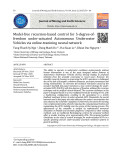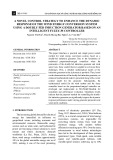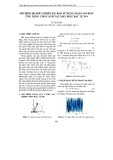
ISSN: 2615-9740
JOURNAL OF TECHNICAL EDUCATION SCIENCE
Ho Chi Minh City University of Technology and Education
Website: https://jte.edu.vn
Email: jte@hcmute.edu.vn
JTE, Volume 19, Special Issue 02, 2024
66
Intelligent Control System based on Wavelet Type-2 Fuzzy Neural network
Design For Robot System
Duc-Hung Pham
Hung Yen University of Technology and Education, Hung Yen, Vietnam
Corresponding author. Email: duchung.pham@utehy.edu.vn
ARTICLE INFO
ABSTRACT
Received:
09/01/2024
In this paper, we propose a wavelet type-2 fuzzy brain imitated controller
(WT2FBIC) for nonlinear robotic systems. The suggested method combines
a wavelet type-2 fuzzy system (WT2FS) and a brain imitated controller (BIC)
to improve learning efficiency. The system's inputs, which comprise a
sensory and an emotional channel, eventually lead to the network's output.
The WT2FBIC parameter update rules use the Lyapunov theory and the
gradient descent method. To correct for the WT2FBIC in a main controller,
a robust controller can be used for compensation. Robots find applications in
a wide variety of industries thus the proposed WT2FBIC-based control
system is used to control nonlinear robotic systems. In this work, a two-
jointed robotic manipulator control system used the proposed method is
demonstrated. The comparison of the proposed method with recent methods
point out the effectiveness of the proposed method. The simulation results
indicate that the proposed control approach provides good control
performance.
Revised:
20/03/2024
Accepted:
29/03/2024
Published:
28/04/2024
KEYWORDS
Wavelet function;
Type-2 fuzzy system;
Brain imitated controller;
Two-joint robot manipulator;
Sliding mode control.
Doi: https://doi.org/10.54644/jte.2024.1519
Copyright © JTE. This is an open access article distributed under the terms and conditions of the Creative Commons Attribution-NonCommercial 4.0
International License which permits unrestricted use, distribution, and reproduction in any medium for non-commercial purpose, provided the original work is
properly cited.
1. Introduction
Robots find applications in a wide variety of industries, including those pertaining to flight [1],
healthcare [1], robot collaboration and cooperation [2], and surgery [3], [4]. The following are some
examples of applications that fall under this category: An example of a highly coupled nonlinear
dynamic multi-input-multi-output (MIMO) system with undetermined system parameters is a robotic
manipulator, which is also known as a robotic arm. It is of the utmost importance that each of the angular
positions of the joint be in the appropriate location, in accordance with the target position that has been
specified for the joint.
In recent years, numerous researchers in the field of control have shown an increasing interest in
biologically inspired algorithms such as fuzzy sets, neural networks [5] to solve challenging
optimization and control problems. As a direct result of the recent development of a mathematical model
for emotional learning in a relatively insignificant region of the human brain, the amygdala, a brand new
scientific subfield known as biologically motivated systems has recently emerged [6]. Researchers in
experimental psychology, artificial intelligence (AI) and cognitive science have long been aware of the
interaction between a person's thoughts and feelings.
This is due to the inaccuracy caused by system uncertainties and external disturbances. The Brain
Imitated Controller (BIC) was developed by Lucas and his colleagues [6] in an effort to find answers to
these problems. BIC is composed of six different components: emotional input, emotional learning,
emotional output, controller output and sensory input. BIC has been integrated with a new system to
improve the overall functionality of the platform, such as the Cerebellar Model Articulation Controller
[7], the Takagi-Sugeno-Kang fuzzy system [8].
A robust controller is required to address nonlinearity and uncertainty. The most common control
algorithm is a robust control algorithm [9], [10]. Therefore, a robust controller is implemented in the
proposed control system to make it stable. Robust control system has been applied for various nonlinear
systems, such as missile guidance control [10], robot system [11], [12], [13], and fault tolerant control
[14]. The robust controller also acts as the compensator to make the control system come to stable better.

ISSN: 2615-9740
JOURNAL OF TECHNICAL EDUCATION SCIENCE
Ho Chi Minh City University of Technology and Education
Website: https://jte.edu.vn
Email: jte@hcmute.edu.vn
JTE, Volume 19, Special Issue 02, 2024
67
Sliding mode control (SMC) is a powerful method that can control both non-linear and linear systems
and has recently been the subject of intensive research by scientists worldwide. The SMC is
characterized by its robustness, stability, good transient response and fast output response. In addition,
the control technology is uncomplicated and easy to use in practice. For these reasons, the SMC is
implementing in this study.
In this work, a combination of a wavelet type 2 fuzzy system and a BIC is created. The new controller
is called Wavelet Type 2 fuzzy brain imitated controller (WT2FBIC). The WT2BBIC is used to control
a two-jointed robotic manipulator.
The main contributions of this paper can be listed as follows:
a) A new WT2FBC is created and parameter of the WT2FBC is updated online by using the gradient
descent method.
b) The system stability is proven by Lyapunov theory.
c) The proposed control system is applied for a two-joint robot manipulator.
d) The comparisons of the proposed method with recent methods point out the effectiveness of
WT2FBC.
The content of this paper can be structured as follows: section 2 presents the problem formulation,
section 3 shows the structure of the proposed method, section 4 presents the parameters and specification
for online learning of the proposed method. Section 4 introduces the simulation results, and finally
section 6 summarizes the conclusions and future directions.
2. Problem Formulation
The formulation of a nonlinear system can be demonstrated in the following:
() ( )) ( ) ( )
n f G u l
(1)
where
()f
and
()G
are nonlinear uncertain functions.
12
( ) [ , ,..., ]
Tm
m
l l l l
is the lumped
uncertainty of the system,
12
[ , ,..., ]
Tm
m
u u u u
is control signal and
12
[ , ,..., ]
Tm
m
. In the
case that one disregards the possibility of uncertainty as well as other kinds of influence of the external
disturbance, the nominal system of (1) can be expressed as follows:
()
00
( ) ( )
nf G u
(2)
where
0 01 02 0
( , , , )
m
diag g g g
G
and
0()f
are the nominal parts of
G
and
f
, respectively. Without
losing generality, it is assumed that
0 0i g
for
.,,1 mi
It is also assumed that the nonlinear system of
(2) is controllable and that
1
0
G
exists. Then, the nonlinear system (1) can be described as
()
00 ()
n f G u l
(3)
where the lumped uncertainty is specified as
()l
, taking into account not only the system's inherent
uncertainties but also any outside disturbances. The task of designing an appropriate control system so
that the output
of the system can follow a desired trajectory vector
12
[ , , ..., ]Tm
r r r rm
. The
tracking error can be defined as
r
e
(4)
If all of these factors
0
f
,
0
G
and
()l
are exactly known, then it will be possible to design the perfect
controller as
1 ( )
00
( ) ( )
nT
r
*
u G f l e
(5)
where
21
,..., , T
m
Γ
are the feedback gain matrix that have positive values. By inserting the
ideal controller into equation (3), one can obtain the dynamic error equation
() 0
nT
eeΓ
(6)

ISSN: 2615-9740
JOURNAL OF TECHNICAL EDUCATION SCIENCE
Ho Chi Minh City University of Technology and Education
Website: https://jte.edu.vn
Email: jte@hcmute.edu.vn
JTE, Volume 19, Special Issue 02, 2024
68
In the event that
Γ
is selected to be a Hurwitz polynomial, it suggests that
lim 0
t e
. However,
()l
cannot be identified in practical applications, so
*
u
is not available. Therefore, a wavelet type-2
fuzzy brain imitated controller (WT2FBIC) can be planned to imitator
*
u
.
3. The structure of proposed method
The proposed WT2FBIC (Figure 1) comprises five spaces: Input space, sensory cortex space, weight
space, amygdala and orbitofrontal cortex space and output space.
Figure 1. The structure of WT2FBIC
3.1. Space 1: Input
12
, ,..., i
i
n
n
I I I R
I
, ni is the input's dimension. Two-channel WT2FBIC using the orbitofrontal
cortex and the amygdala. When it comes to making decisions based on feelings, the amygdala channel
is involved, whereas the orbitofrontal cortex channel is used for emotional control. One way to describe
fuzzy rules is as follows:
1 1 2 2
If is and is ... and then and , for =1,2,..., ; 1,2,..., .
ii
ao
j j n n o ijo o ijo j o
I S I S I is S A W O W j n o n
(7)
where
ij
S
is the fuzzy set connected the i-th input to the j-th space;
, , and
j i o
n n n
are respectively the
dimension of layer space, input space, and output space;
,
oo
OA
are orbitofrontal and amygdala channel,
respectively.
3.2. Sensory cortex space
First, let set:

ISSN: 2615-9740
JOURNAL OF TECHNICAL EDUCATION SCIENCE
Ho Chi Minh City University of Technology and Education
Website: https://jte.edu.vn
Email: jte@hcmute.edu.vn
JTE, Volume 19, Special Issue 02, 2024
69
i ij
ij
ij
I
v
(8)
where
ij
and
ij
v
are respectively the center and upper dilation. Upper wavelet function is given as
follows
12
()
22ij
ij ij
Se
(9)
where
ij
and
ij
v
are respectively the center and lower dilation. Lower wavelet function is given as
follows
i ij
ij
ij
I
v
(10)
12
()
22ij
ij ij
Se
(11)
3.3. Weight space
Upper and lower weights of sensory and emotional are
a
ijo
W
,
a
ijo
W
,
o
ijo
W
and
o
ijo
W
, respectively.
3.4. Amygdala and orbitofrontal cortex space
1 1 1 1
1 1 1 1
1()
2
jj
ii
jj
ii
nn
nn
l a r a
ij ijo ij ijo
i j i j
onn
nn
lr
ij ij
i j i j
S W S W
A
SS
(12)
1 1 1 1
1 1 1 1
1()
2
jj
ii
jj
ii
nn
nn
l o r o
ij ijo ij ijo
i j i j
onn
nn
lr
ij ij
i j i j
S W S W
O
SS
(13)
The calculation of the reduction from type-2 to type-1 with the Karnik-Mendel algorithm, as shown in
[9], is possible.
,
, others
lij
ij
ij
SjL
SS
(14)
,
, others
rij
ij
ij
S j R
SS
(15)
where R and L are the right and left switching point.
3.5. Output space
The o-th output of WT2FBIC could be caculated as
o o o
uO=A
(16)
Then the output of proposed controller can be calculated as follows
21
o
n
WT FBIC o o
o
O
u = A
(17)
4. Parameters and specifications for online learning of the WT2FBIC
A cost function is selected as the

ISSN: 2615-9740
JOURNAL OF TECHNICAL EDUCATION SCIENCE
Ho Chi Minh City University of Technology and Education
Website: https://jte.edu.vn
Email: jte@hcmute.edu.vn
JTE, Volume 19, Special Issue 02, 2024
70
2
cost 1
1()
2
o
n
oo
o
F d u
=
(18)
where
o
d
is the desired control output. The formula for updating the parameters can be derived as
cost ()
( 1) ( ) ( ) ( ) Ft
t t t t
(19)
where
can be one of these variables
, or
ij ij ij
vv
.
are the learning rates. According to the structure
of the proposed controller in figure 1, the cost function and by using the chain rule and gradient descent
method, the parameters updating can be holded as follows [10].
( ) ( ) ij ij ij ij
oo
ij
ij o ij ij ij ij ij ij
S F S F
uu
tt
u S F S F
22
( ) ( )
22
22
( )( ) 2 ( )( ) 2
FF
a o a o
ijo ijo ijo ijo
i ij i ij
FF
W W F e F W W F e F
II
22
22
( ) ( )
22
22
22
( ) ( )
FF
a o a o
ijo ijo ijo ijo
i ij i ij
FF
W W F e W W F e
II
(20)
22
22
( ) ( )
a o a o
ij ijo ijo ij ijo ijo ij
i ij i ij
FF
W W S W W S
II
(21)
2
1
( ) ( ) ( 2)
()
o
n
ij ij ao
oo
ij v v v ijo ijo ij
o
ij o ij ij ij ij ij
SS
uu
t t F
v W W S
v u S v S v v
(22)
2
1
( ) ( ) ( 2)
()
o
n
ij ij ao
oo
ij v v v ijo ijo ij
o
ij o ij ij ij ij ij
SS
uu
t t F
v W W S
v u S v S v v
(23)
CONTR OL SY STEM
ΣΣ
e
r
ΣΣ
Wavelet Type-2 Fuzzy
Neural net work
Robust Controller
s
Sliding
Surface
u
Uncertain Nonlinear System
() ( )) ( ) ( )
n
f G u l
2WT FBIC
u
robust
u
s
Figure 2. Proposed control system diagram
The proposed WT2FBIC is examined to mimic the ideal controller. The proposed control system is
shown in Figure 2, which includes a main controller
WT2FBC
u
and a robust controller
robust
u
as follows
tWT2FBI robusC
*
u u u
(24)
where
robust
u
is used for compensating the error between
*
u
and
WT2FBIC
u
to attain robust performance.












![Đề cương đề tài nghiên cứu khoa học [chuẩn nhất/mới nhất]](https://cdn.tailieu.vn/images/document/thumbnail/2025/20251117/duong297/135x160/26111763433948.jpg)













